Đà Lạt or Dalat, (pop. 206,105 as of 2009, of which 185,509 are urban inhabitants) is the capital of Lâm Đồng Province in Vietnam. The city is located 1,500 m (4,900 ft) above sea level on the Langbian Plateau in the southern parts of the Central Highlands region. In Vietnam, Da Lat is a popular tourist destination.
Da Lat’s specific sights are pine wood (forming the name: “City of thousands of pine trees”) with twisting roads and tree marigold (Vietnamese: dã quỳ) blossom in the winter. The city’s temperate weather stands in contrast to Vietnam’s otherwise tropical climate. Mist covering the valleys almost year-round leads to its name “City of eternal spring”.
Da Lat is also known as an area for scientific research in the fields of biotechnology and nuclear physics.
With its year-round cool weather, Da Lat supplies temperate agriculture products for all over Vietnam, for example: cabbage and cauliflower. Its flower industry produces two typical flowers: hydrangea (Vietnamese: cẩm tú cầu) and golden everlasting (Vietnamese:hoa bất tử). The confectionery industry offers a wide range of mứt, a kind of fruit preserve made from strawberry, mulberry, sweet potato, and rose.
According to some sources, the name derives from the acronym of the
Latin phrase 'Dat Aliis Laetitiam Aliis Temperiem' ("It Gives Pleasure
to Some, Freshness to Others"), which the French colonial government
used in their official emblem of Đà Lạt. In reality, the name Da Lat
derived from the language of the local ethnic group Lạt and its original
meaning is "Stream of the Lạt", and the acronym above is in fact a backcronym
During the 1890s, explorers in the area (including the noted bacteriologist Alexandre Yersin, protégé of the renowned French chemist Louis Pasteur), which was then part of the French territory of Cochinchina, asked the French governor-general, Paul Doumer, to create a resort center in the highlands. The governor agreed. The original intended site for the hill station was
Dankia, but Étienne Tardif, a member of the road-building expedition of
1898-99, proposed the current site instead. In 1907, the first hotel
was built. Urban planning was carried out by Ernest Hébrard.[1]
The French endowed the city with villas and boulevards, and its Swiss
charms remain today. Hébrard included the requisite health complex, golf
course, parks, schools, and homes but no industry. The legacy of
boarding schools where children from the whole of Indochina were taught
by French priests, nuns, and expatriates still
existed as late as 1969. In 1929, the Christian and Missionary Alliance
established a school (Dalat International School) for Canadian and
American children of missionaries serving in Southeast Asia. In 1965,
the school moved to Bangkok, Thailand; then in 1966 to the Cameron
Highlands in Malaysia and then, in June 1971, moved to its present
location in Georgetown, Malaysia. There were seminaries of Jesuits (such as Pius X Pontifical College) and other orders. The elite Vietnamese National Military Academy graduated its first class of future leaders in 1950. There was an aviation school at Cam Ly Airport.
During World War II, Đà Lạt was the capital of the Federation of Indochina, from 1939 to 1945.
In the mid-1950s, the Vietnamese Scout Association established their national training grounds at Đà Lạt.
The only major involvement Da Lat had during the Vietnam War was within the 1968 Tet Offensive.
Fierce battles raged from January 31 to February 9, 1968. Most of the
fighting took place between the South Vietnamese MP units stationed in
Đà Lạt and the Việt Cộng (VC)
forces. American MPs were also involved in the fighting and suffered
several KIAs during a rocket attack on their compound. Defeats and
victories alternated between the two during the sporadic-yet-intense
battles. However, the South Vietnamese MPs were eventually able to
regain control of Đà Lạt. It is stated that around 200 VC were
killed-in-action (KIAs) during this battle. Although South Vietnamese MP
forces were known to have significantly fewer KIAs, their injured list
grew steadily throughout the engagement because of periods of low
supplies and support. What ultimately saved the South Vietnamese MPs was
the fact that they held strong defensive positions throughout Đà Lạt
from the beginning to the end of the battles.
-Hình ảnh Đà Lạt trước năm 1975 :

Đà Lạt Market - Tuyên Đức 1969 - Photo by Tom Petersen

Đà Lạt 1969
NHÀ THỜ CHÍNH TÒA ĐÀ LẠT – NHÀ THỜ CON GÀ
NHÀ THỜ CHÍNH TÒA ĐÀ LẠT – NHÀ THỜ CON GÀ
Tượng đài Đức Mẹ Fatima bên cạnh nhà thờ, nằm giữa rừng thông,
phía trước nhà xứ:
Dalat Cathedral
The Dalat Cathedral began to be built in the year 1931 and was completed in 1942.
As most of the buildings of the Vietnam of Indochina, the stained glass
windows were brought directly from France, 70 stained glass to be
exact.
The building measures 65 meters long, 47 meters high and 14 meters wide, which makes this Cathedral the largest church in Dalat.
The main entrance of the Church is oriented towards the Lang Biang mountain and walls of the Cathedral, made of masonry, have a thickness of 40 centimeters.
Every year at Christmas, thousands of worshipers congregate inside and around the cathedral to celebrate.

Tượng Chúa nhìn vào nhà thờ, ảnh chụp sau lưng Tượng từ phía đường
Lê Đại Hành và hình ảnh nhà thờ lúc chưa quét sơn lại:
đặt Thánh
giá trên đỉnh và vào ngày 14.11.1941, đặt con gà bằng hợp kim nhẹ rỗng,
bên trong được tráng phủ một lớp hoá chất đặc biệt đồng dài 0,66m, cao
0,58m quay quanh một trục bạc đạn để chỉ hướng gió. Con gà có thể là
biểu tượng của nước Pháp (Coq gaulois: gà trống xứ Gaulle),có thể là
biểu tượng của sự sám hối vì theo đoạn Tân Ước kể lại việc Chúa Giê-su
quở trách Phê-rô (một trong 12 tông đồ của Người): “Ðêm nay gà chưa gáy,
con sẽ chối Ta ba lần…”.(Ga 13, 21-38) có ý nhắc nhở mọi người phải
tỉnh thức và cầu nguyện.
Cận cảnh “ con gà” nổi tiếng của Nhà thờ, “chú gà” này đã đứng ở đây trên 70 năm (từ năm 1941):
The
gingerbread-style Dalat Cathedral was built between 1931 and 1942 for
use by French residents and holiday-makers. The cross on the spire is
topped by a weathercock, 47m above the ground.

Nhà Thờ chính tòa Đà Lạt năm 2012
Originally called the Lang-Bian Palace Hotel,
it was completed and opened in 1922, at the height of an economic boom,
and was designed to be a site of colonial leisure and power. 'The
hotels monumentalism, modernity, luxury and location made it a
conspicuous symbol of French domination over the Indochinese central
highlands.' It
was positioned at the centre of a European business and administrative
quarter, dominated the "native quarters" and served as a buffer between
them and the European villas. As a luxurious establishment it could act
also as a serene base from which to explore highland minority villages
or conduct big-game expeditions, and meant to compete with the poshest
colonial hotels of Southeast Asia, such as the Oriental Hotel, Bangkok and the Raffles Hotel, Singapore. It
initially featured thirty-eight luxury rooms, as well as an orchestra, a
cinema, tennis courts, private fruit and vegetable gardens, a dance
hall, riding facilities, gymnastic equipment and a French restaurant.
Architectutrally the Palace followed metropolitan French resort styles,
merging elements of spa towns like Vittel with seaside architectural elements borrowed from towns like Cabourg or Cannes. French novelist w:fr:Morgan Sportès, in his depiction of Indochina during WW2, has described it as reminiscent of the Negresco Hotel, in Nice.When
economic circumstances changed, later in the 1920s, most plans for
government structures in Dalat were abandoned, leaving the town with a
Palace Hotel as its monumental centerpiece.
In
1925 a city health inspection reported that the kitchens and their
surroundings exhibited, "a condition of considerable filth"
The Lang-Bian Palace Hotel in the 1920s -it was completed and opened in 1922 before Vichy governor general of Indochina, Jean Decoux, in 1943, got rid of the ornate façade.
In 1943, under the Vichy governor general of Indochina, Admiral Decoux,
the façade was altered, and changed to a starker exterior. This was
'almost certainly inspired by architect Paul Vesseyre's two other
'Palaces' in Dalat, Bao Dai's and the governor generals, built in 1934 and 1937 respectively, in a style more of art deco or even Bauhaus than of the fin-de-siècle spa
style.' Decoux did not like what he regarded as out-dated
ornamentation and was part of a movement at this time to simplify
complex lines and to cut out rococo elements. Other examples of Decoux's attitude were the treatment he visited upon the palace of the governor general of Cochinchina in Saigon, removing the two caryatids, and the celebrated Saigon theatre, whose statues and bas-reliefs were destroyed on Decoux's orders.

Dalat Palace Hotel - 1966
Dalat Palace is a living
testament to a bygone era. Built under the French Governor, it first
opened in 1922.The hotel underwent extensive renovation and
refurbishment in 1993. It later reopened in 1995.The majestic style and
historical architecture has been maintained. The History of the Climate
Resort of Dalat gravitates around the named “Hotel Du Lang Bian” or “Lang Bian Palace Hotel”.
Soon after being discovered by
Professor Alexandre Yersin in 1893, the decision was taken to create a
Climate Resort on the Lang Bian plateau.
The construction of the town started in 1905; a Hotel of First Category or “Palace Hotel”
as the French would name them was necessary to attract the high society
of Saigon. The architecture, style and concept was done before WWI and
started in 1914. This delayed the start of construction which begun in
1916. The Lang Bian Palace opened in 1922, it was then the largest
building of the whole area, located ideally facing the man-made lake,
opposite the land kept for the future Golf course.
Dalat has many homes built of
wood much like the Swiss chalets found in the Alps. It also has many
grand villas built by French officials during the early part of the
century.
The city literally developed
around the hotel. It was first refurbished in 1942, when Dalat was
planned to become the Capital City of Indochina, gathering Viet Nam,
Cambodia and Laos. The style was the modern Art Deco trend of the late
30’s.
It remained open as a hotel since
its opening until now, even throughout wars and uncertain times. The
latest remodelling occurred in the early 1990’s, to be restored in its
grand Victorian style that you can enjoy today at the Dalat Palace
Luxury Hotel & Golf Club.
Larry Lee Hillblom (May 12, 1943 – May 21, 1995) was an American businessman, and a co-founder of DHL Worldwide Express, a shipping company
In Vietnam, he spent $40 million to restore the Dalat Palace Hotel as
well as the Dalat Palace Golf Course, in an attempt to recreate colonial
times. Other investments included the Novotel Dalat, Novotel Phan Thiet
and Ocean Dunes Golf Course and the Riverside Apartments outside Ho Chi
Minh City. The investment was done via an overseas holding company to
avoid an American embargo against
Vietnam. The Dalat Palace Hotel featured French restaurants and
"Larry's Bar". The hotel opened in 1995 under Hillblom and his
Vietnamese partners' ownership with management personnel provided by
Accor.
Hillblom is described in his biography by James Scurlock, King Larry: The Life and Ruins of a Billionaire Genius, as having raped underage girls after moving to Saipan
Dalat Palace Hotel_2010
Xuan Huong lake from Dalat Palace Hotel_ 2006
GIÁO XỨ DU SINH
NHÀ THỜ DU SINH
Hai
chữ “Du-sinh” có nghĩa là Giu-se, theo cách phiên âm của cha Bửu Dưỡng,
người sáng lập giáo xứ. Về sau, có người giải thích rằng “du sinh” nói
lên nguồn gốc của những cư dân tại đây, vì họ như những dân du mục rày
đây (miền Bắc) mai đó (miền Nam); sâu xa hơn, “du sinh” còn nhắc người
tín hữu của Đức Ki-tô về cuộc lữ hành trần thế.
Nhà
thờ Cổ Du Sinh tọa lạc trên một ngọn đồi thuộc số 12B đường Huyền Trân
Công Chúa, thành phố Đà Lạt. Ngôi thánh đường cổ này được xây dựng năm
1955, do Linh Mục Thiên Phong Bửu Dưỡng thành lập cho bà con giáo dân di
cư từ miền Bắc vào, bảo là xây tạm, bởi vì Linh Mục này có mơ ước xây
dựng một ngôi thánh đường mang nét kiến trúc Á Đông, nhưng cha phải vâng
lời thuyên chuyển công tác quá sớm nên giấc mơ không thành.
Linh
Mục Thiên Phong Bửu Dưỡng là con cháu của các vua triều Nguyễn. Sau một
thời gian theo tu học ở các ngôin chùa Phật giáo, Cha gia nhập đạo
thiên chúa và theo tu học ở dòng Đa Minh, rồi được tấn phong Linh Mục.
Ngôi
nhà thờ tạm cổ vẫn tồn tại cho đến nay với lối kiến trúc Á Đông. Bốn
trụ cột của tháp chuông và các cột chính của nhà thờ được làm bằng gỗ,
được chạm khắc như hình dáng của cây tre, cây trúc, là hình ảnh thân
thương của người việt. Đường kính của mỗi cột tre, cây trúc khổng lồ này
khoảng 40cm. Trên thân mỗi cây cột đều được khắc các dòng kinh thánh
hay thánh vịnh bằng chữ Nôm.
Đà Lạt Aerial 1969
Dalat, et son atmosphère française
Dalat, c’est la petite France, avec ses villas coloniales au milieu des pins…L’endroit
a été reconnu par Yersin en 1893, puis proposé à Paul Doumer, alors
Gouverneur de l’Indochine, pour y fonder une station d’altitude,
permettant aux Saïgonnais de bénéficier de la douceur du climat. Située à 300 km de Saigon et à 75km de la mer, Dalat est à 1500 mètres d’altitude.
Elle
mettra du temps à prendre son essor, car son isolement dans une vallée
fort boisée et difficile d’accès nécessite des infrastructures
onéreuses. De plus, les fonctionnaires préféraient bénéficier du congé
périodique en France, dont le coût du transport par bateau était payé
par l’administration, plutôt que de rester en Indochine.
C’est finalement la 1ère guerre
mondiale – et l’isolement de l’Indochine - qui va accélérer le
développement de cette station. Les villas se multiplient apres 1917, le
Golf vers 1920, le Grand Hôtel en 1922, et la cathédrale dans les
années 30. Une ligne de chemin de fer relie Dalat au littoral dès 1933.
C’est
surtout la présence de nombreux gibiers (éléphants, tigres, gaur …) qui
va faire connaître la station dans le monde entier. Les chutes d’eau
sont aussi nombreuses que spectaculaires.
Par la suite, la ville a été protégée de la guerre par un accord tacite entre les belligérants.
Aujourd’hui,
la ville compte plus de 150.000 habitants et les édifices construits du
temps des français est encore nombreux. On recense encore plusieurs
centaines de villas de l’époque coloniales et de jolis bâtiments publics
(gare, église, université, écoles, couvents, le Palais Bao Dai..).
La
ville vietnamienne s’est fortement développée, et a envahi la plupart
des parcelles disponibles, mais Dalat garde son atmosphère particulière.
Les Vietnamiens (voyage de noce notamment) sont nombreux a s’y rendre.
Quant aux occidentaux, ils sont souvent déçus, en raison justement du
manque d’exotisme de la cite, de la pluie et de la fraicheur du climat.
Les
richesses de la ville aujourd’hui, en dehors du tourisme, ce sont les
cultures maraîchères et horticoles. Les artichauts (pour les tisanes),
les fraises et les roses de Dalat sont célèbres dans tout le sud
Vietnam.
Le
« Palace Hôtel », superbe bâtiment construit en 1922, est gèré
aujourd'hui par le groupe Accor. Il dispose d’une large vue donnant sur
le lac et derrière, le golf. C’est l’un des rares endroits ou la vue
reste dégagée…
La
gare de Dalat, qui ressemble fortement a celle de Deauville… Seuls
quelques kilomètres de rails sont encore utilisés pour les touristes.
Le Lycée Yersin, édifice en brique et pierres aux lignes arrondies…
Nombreuses sont les congrégations religieuses présentes à Dalat. Le « Couvent
des Oiseaux », qui a vu passer toute l’élite vietnamienne avant 1975,
est le plus célèbre. Trois religieuses veillent aujourd’hui sur ce
trésor du temps passé.
Đà Lạt 1969



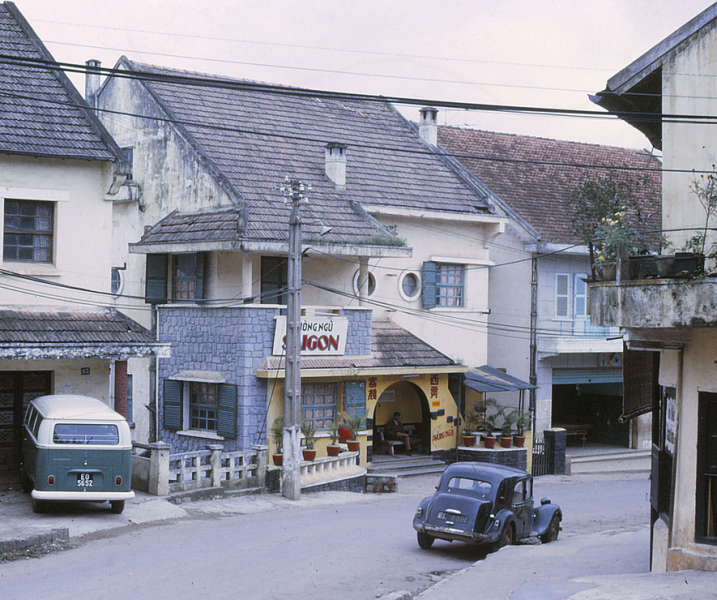

Chùa Linh Sơn



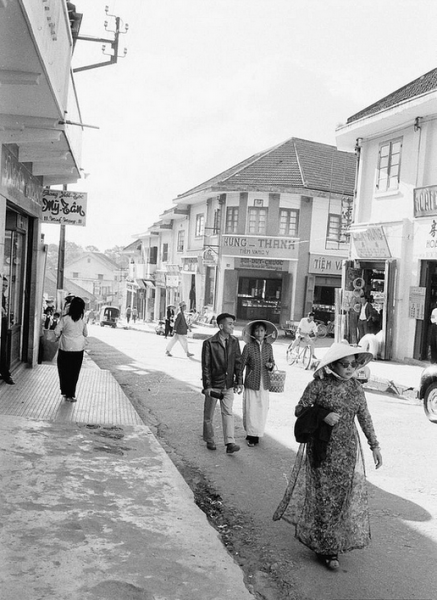

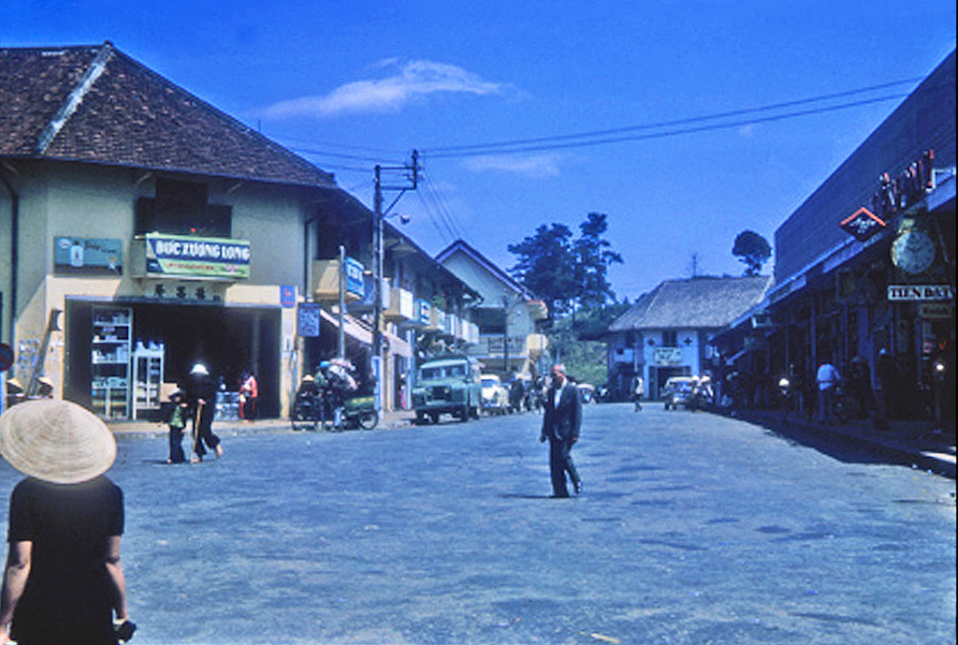





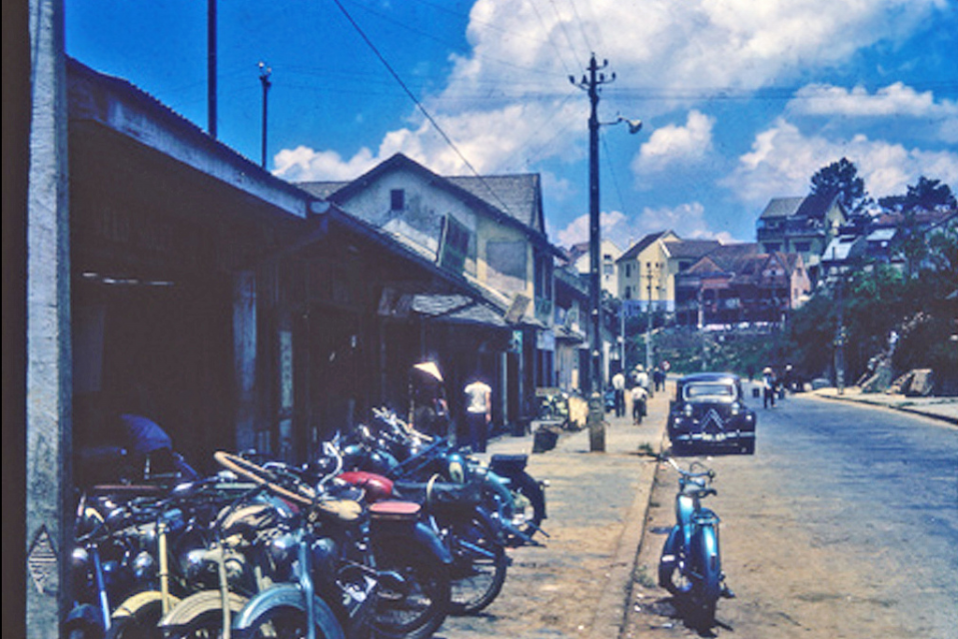


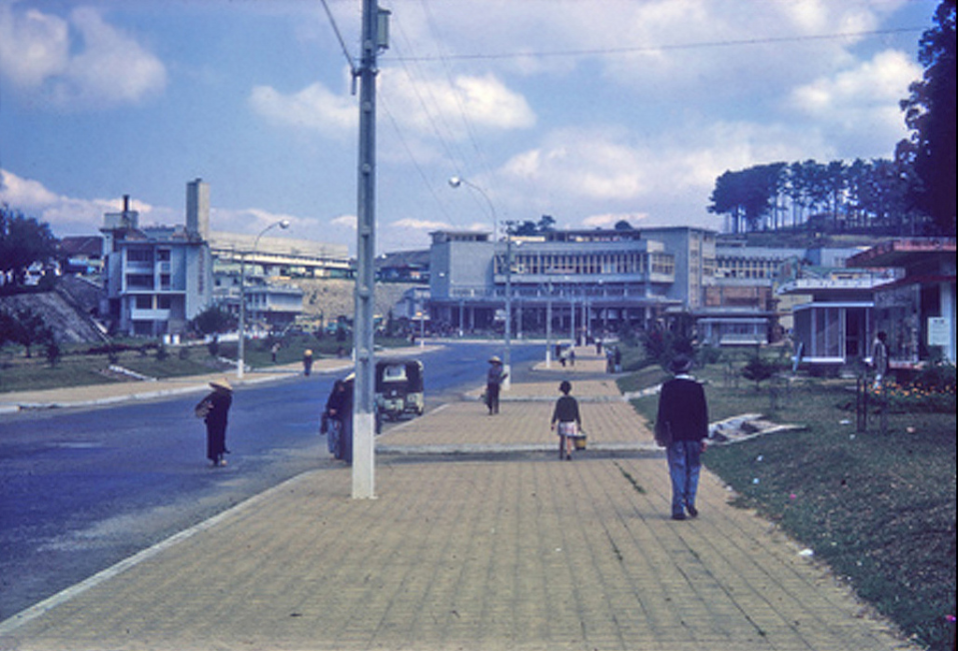
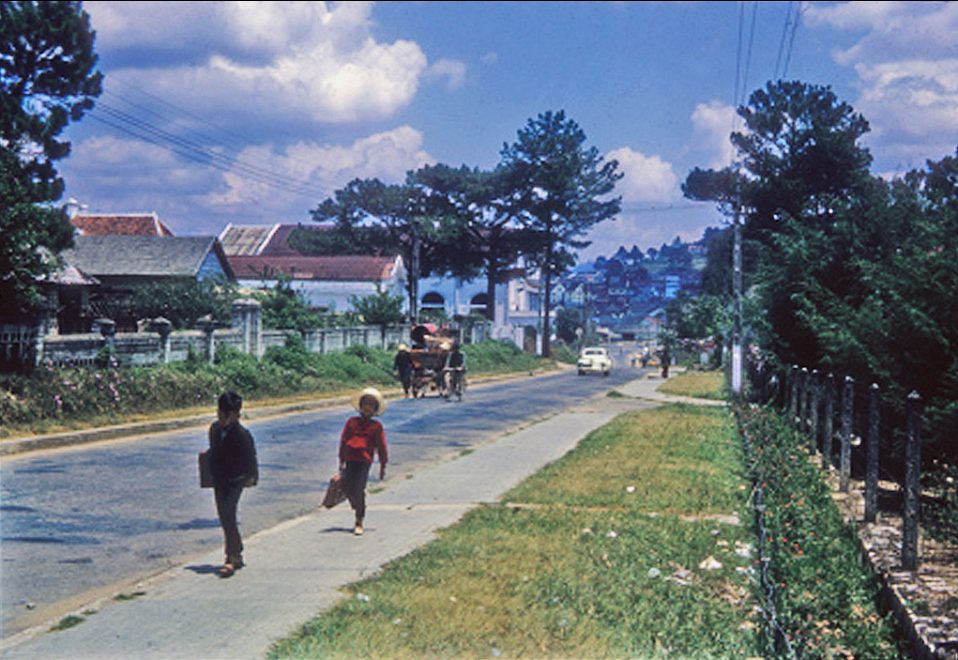

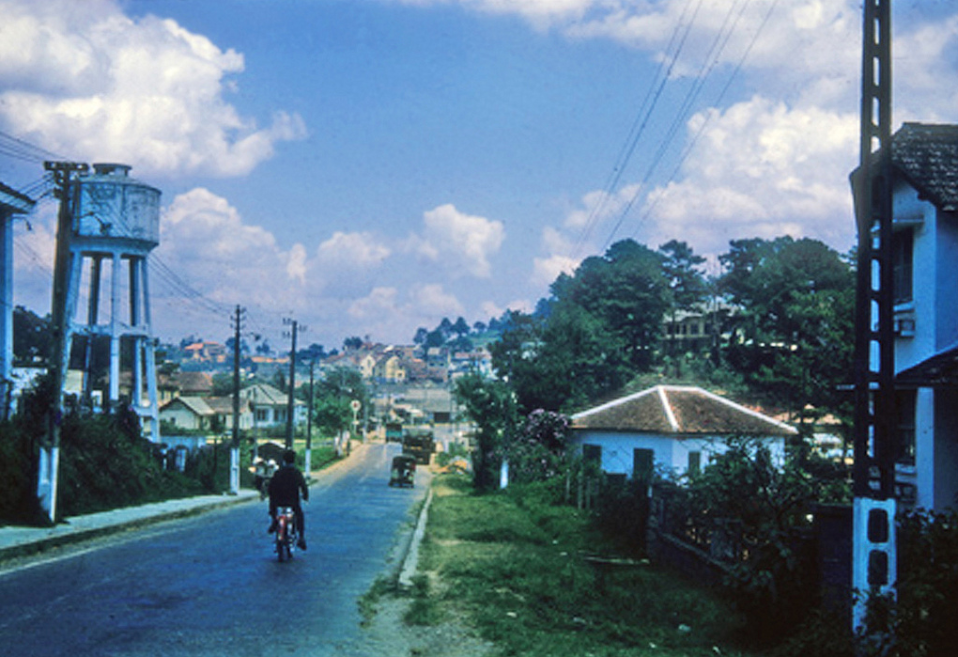

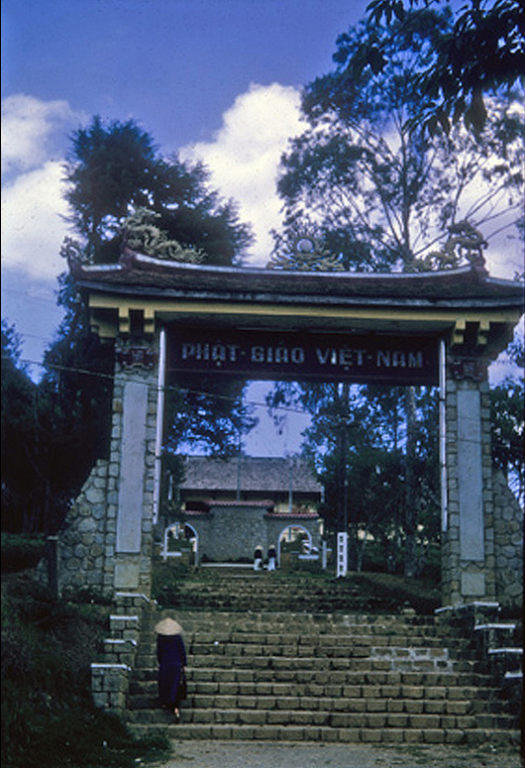
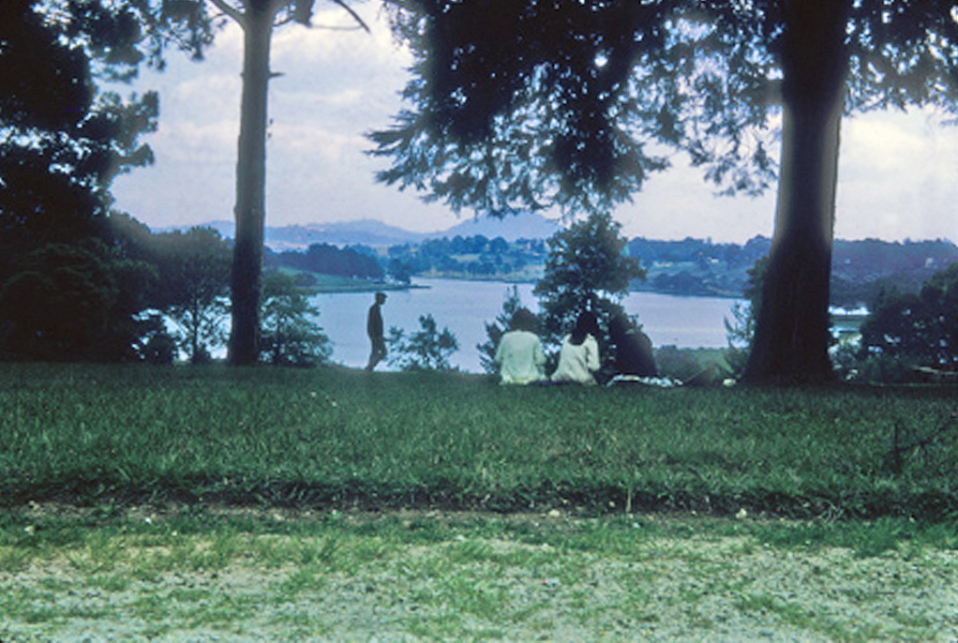
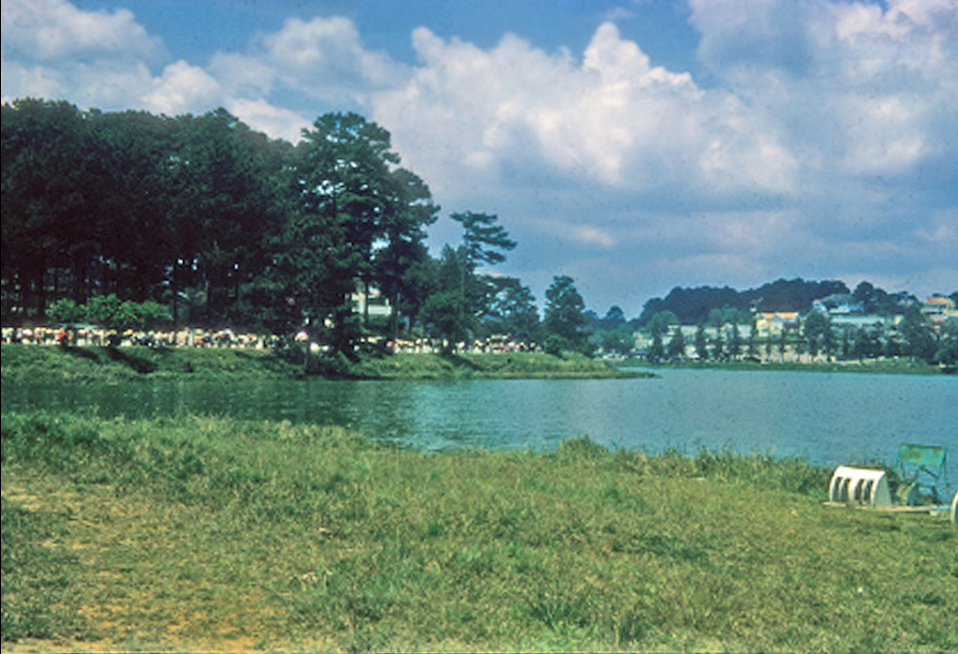
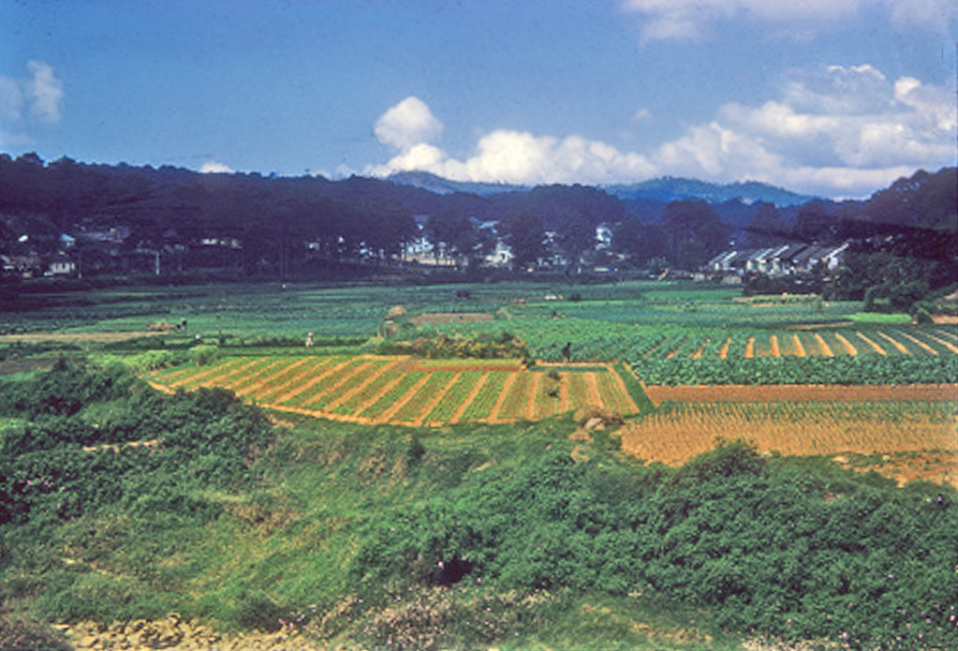
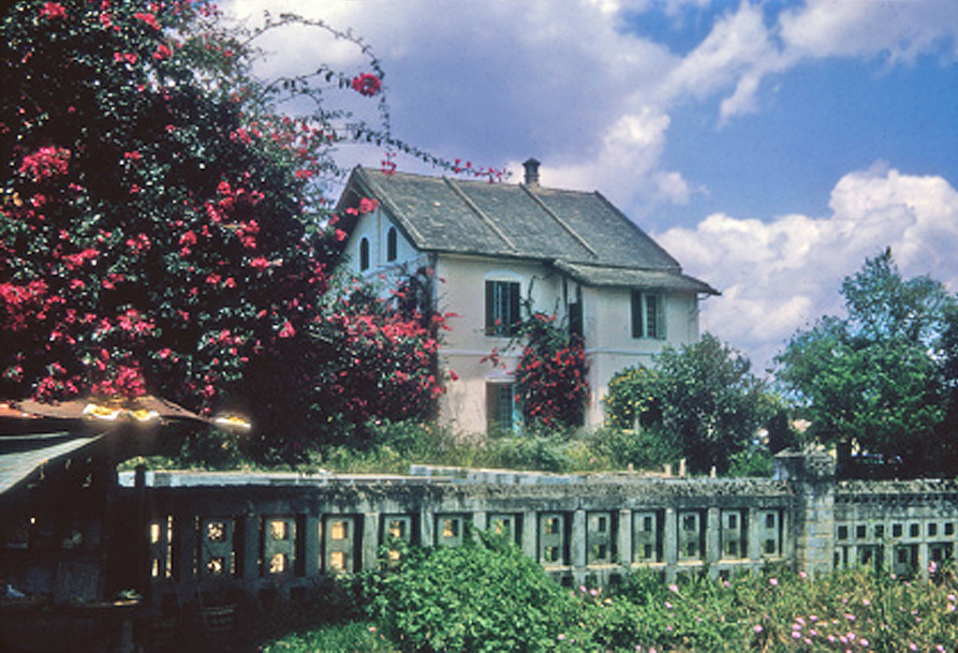

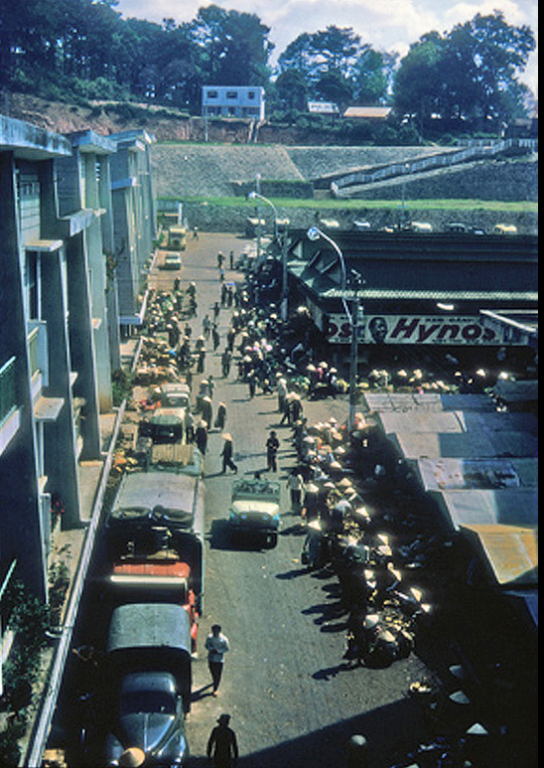
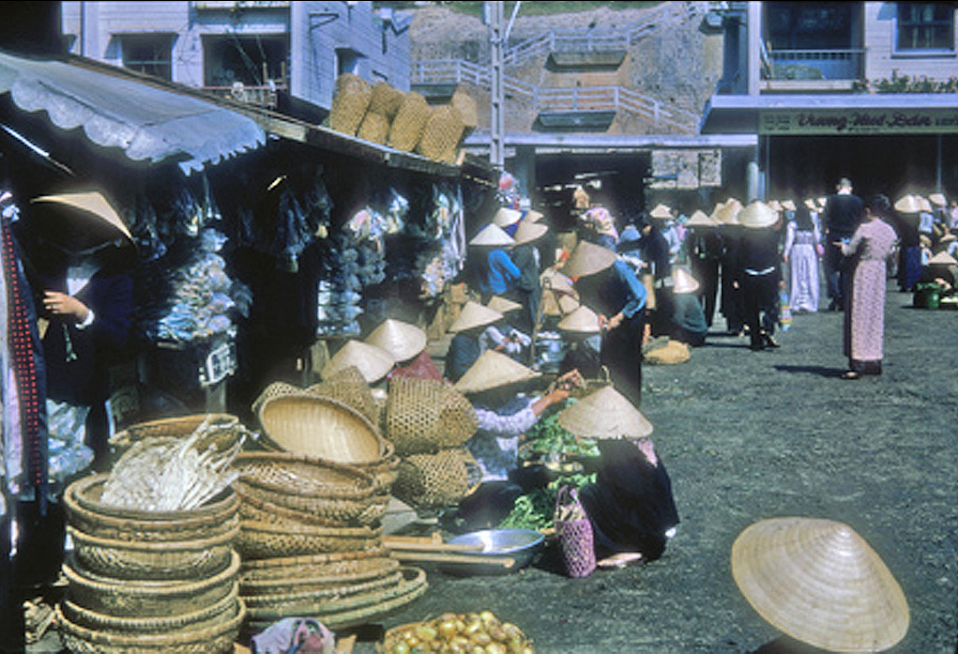
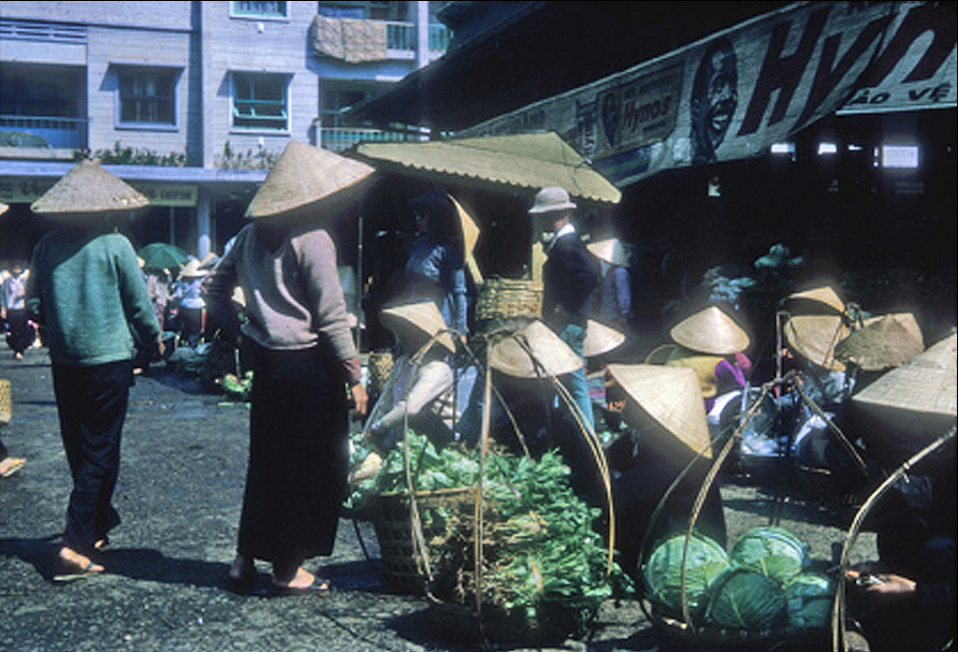
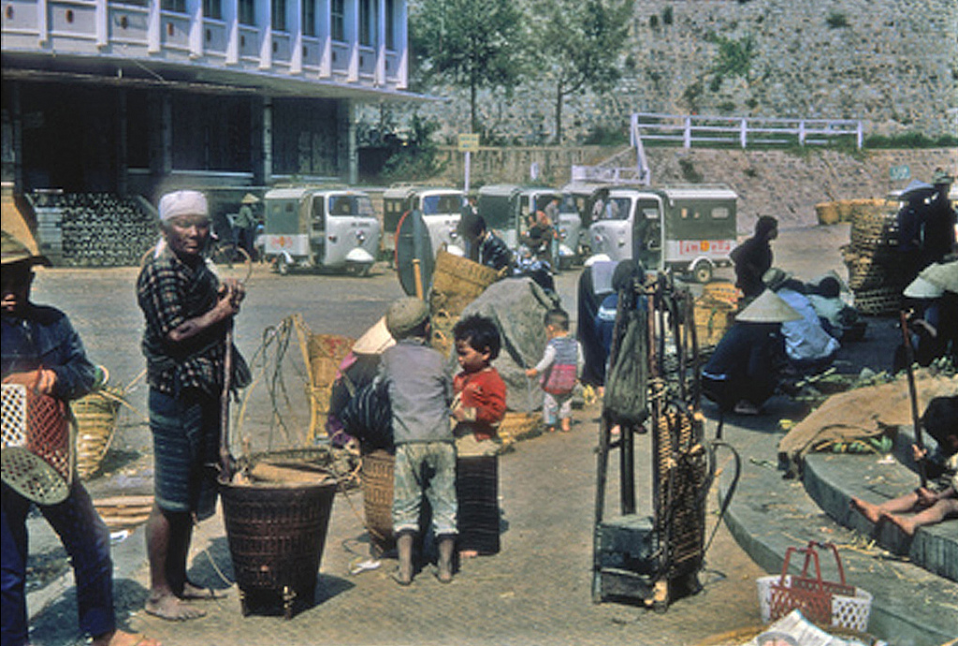
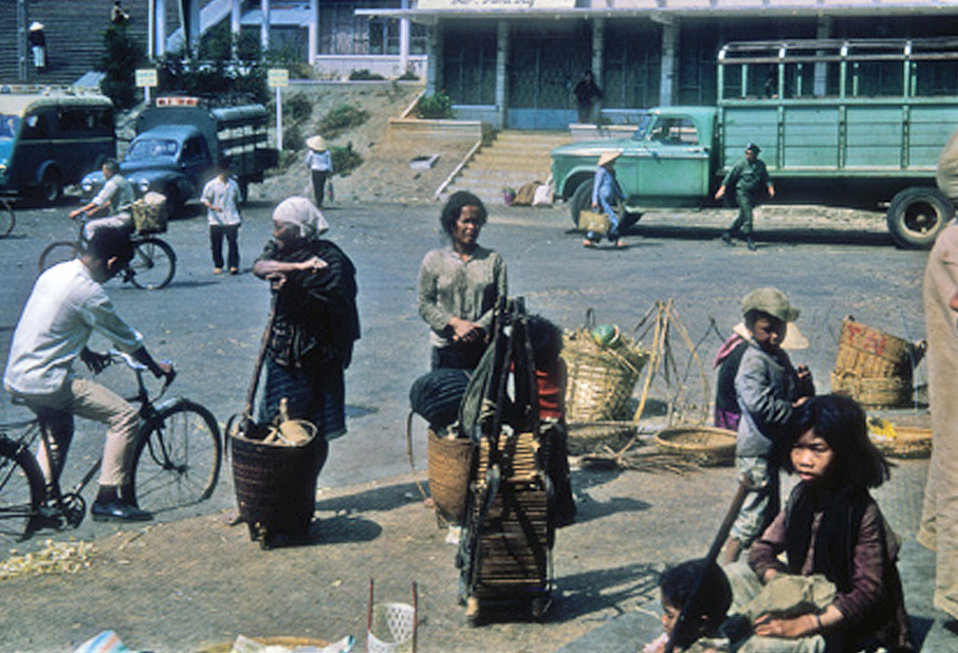
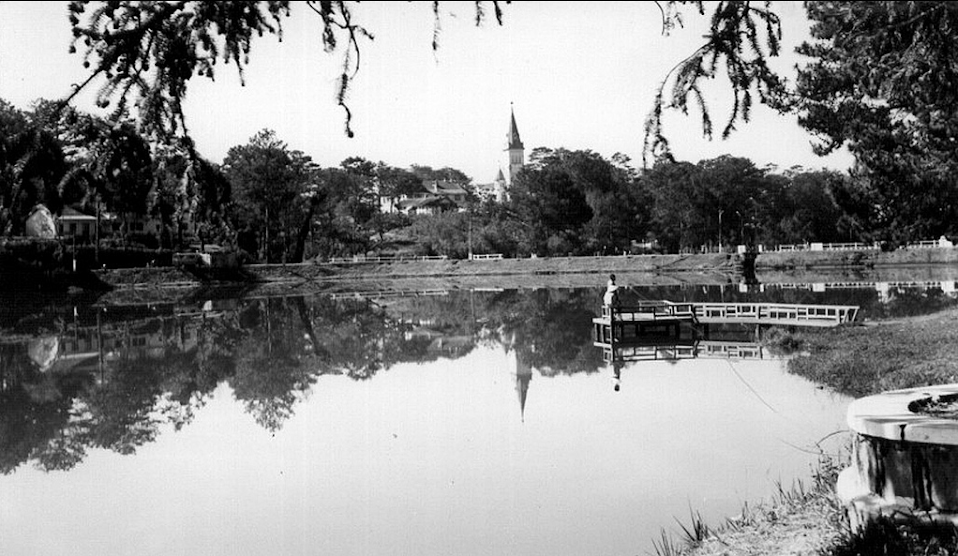
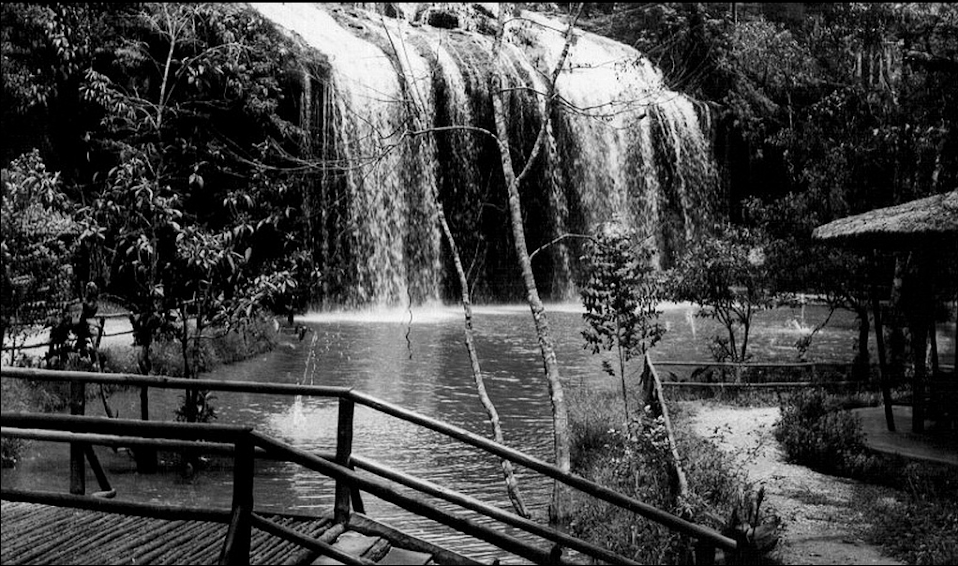
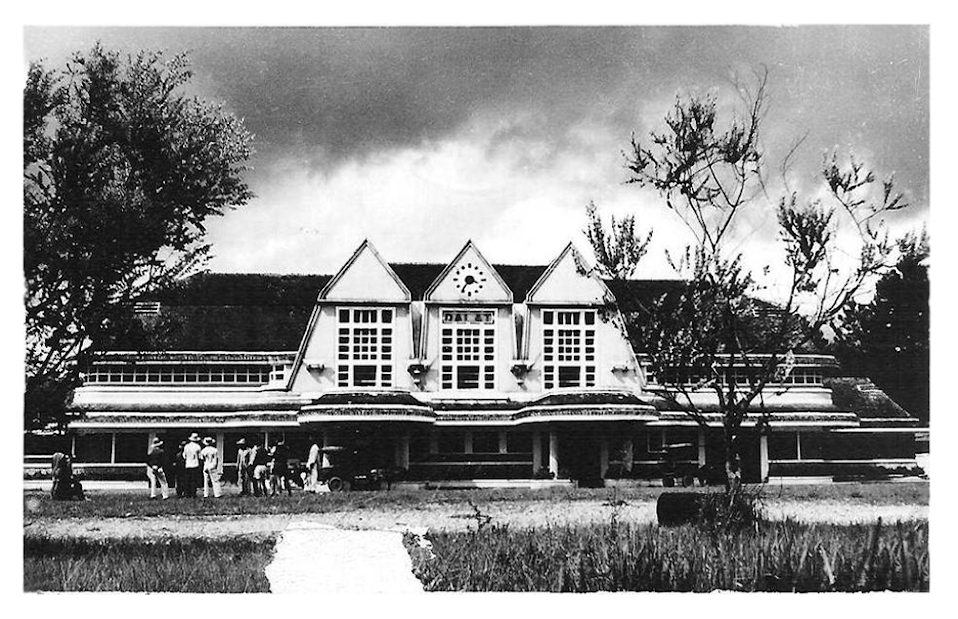
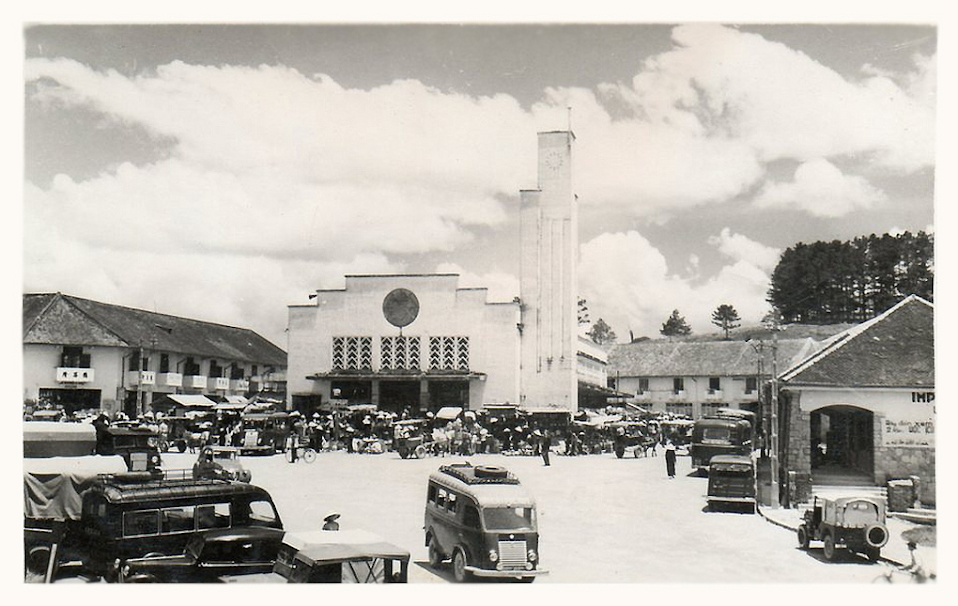
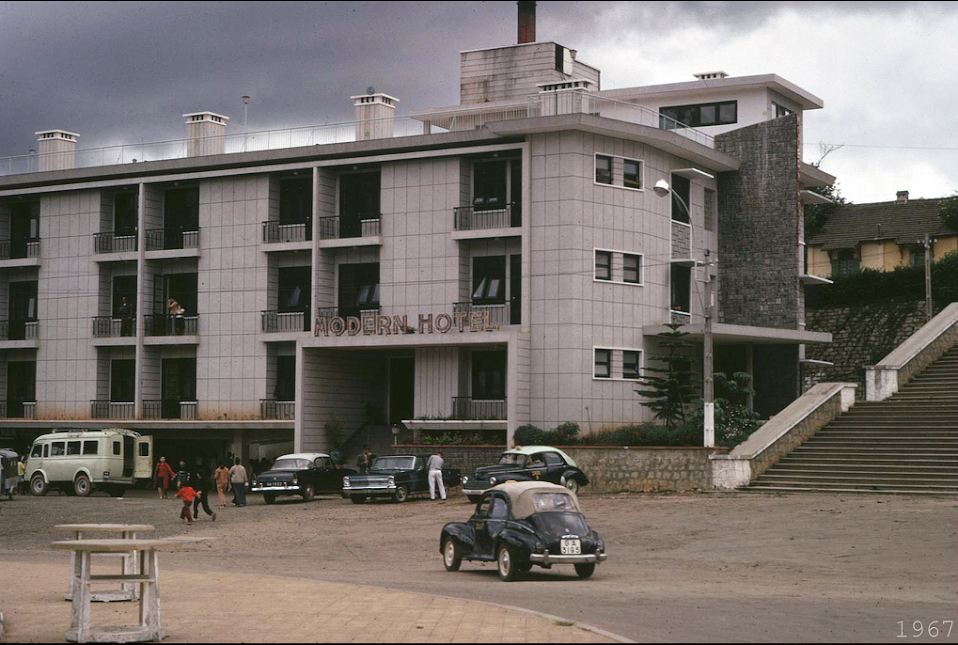
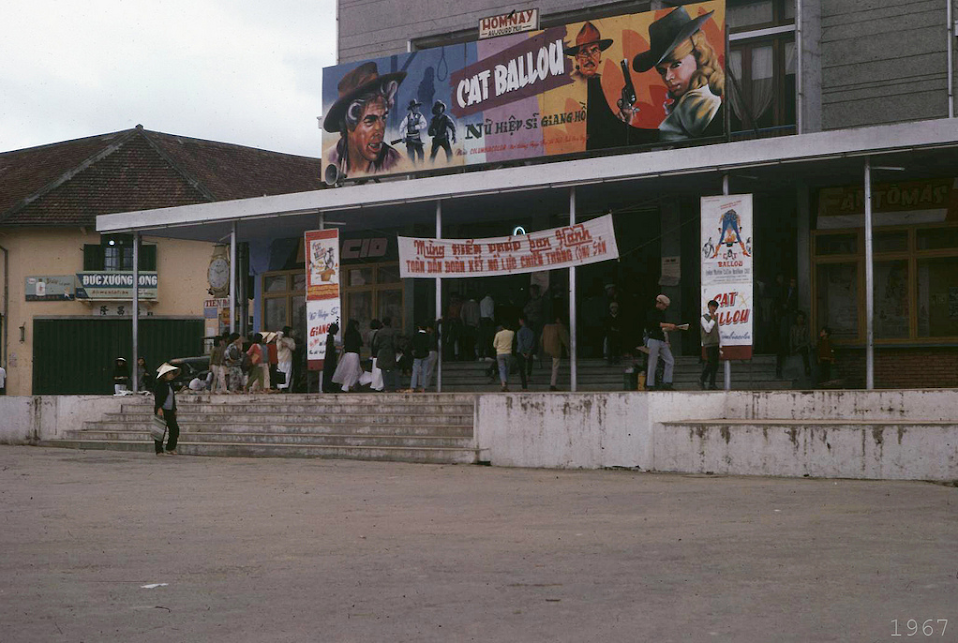
-MUSIC VIDEO :--Chiều Vàng (Nguyễn Văn Khánh) Khánh Ly (1963)
"pédal’eau"
Liên Khương Terminal - Đà Lạt 1960 - Photo by Ross Mc' Kimmey

Liên Khương Airport - Photo by Peter A. Bird 1971
-Dalat Cam Ly - At The Airfield :
The
14th Aerial Port facilities at Dalat Cam Ly. Although it is not easy
to read in this small image, the large white sign points out in graphic
detail that the city is off-limits to all U. S. military personnel.
Cột cờ sân bay Cam Ly - 1966/72
Cam Ly Airport - Tuyên Đức Aerial 1968 - Photo by Carl Mydans
Cam Ly AF - Đà Lạt 1967/68 - Photo by Hans Herm
Cam Ly Camp - Đà Lạt 1964/67 - Photo by Rhodes

THÁC PRENN_DA LAT


Thác Pongour còn gọi là thác Bảy tầng nằm tại huyện Đức Trọng, tỉnh Lâm Đồng, cách Đà Lạt 50 km về hướng Nam

Gougah Falls
Thác Gougah còn có tên gọi là thác Ổ Gà, nằm sát quốc lộ 20, thuộc xã Phú Hội, huyện Đức Trọng, cách Đà Lạt khoảng 37km

Dalat - Lien Khang Chute 1925-30
Thác Liên Khương có tên cũ là Liên Khàng, nằm ngay ngã ba Liên Khương, thuộc huyện Đức Trọng, cách thành phố Đà Lạt gần 27 km, bên cạnh quốc lộ 20

Đà Lạt Aerial 1969

Nhà thờ Domaine de Marie _Dalat

Đà Lạt Aerial 1969
Nhà thờ và tu viện Domaine de Marie
Nhà thờ được xây dựng từ năm 1930 đến 1943 theo phong cách châu âu của thế kỷ 17, Nhà thờ kết hợp giữa kiến trúc nhà rông tây nguyên và kiến trúc phương tây . Nơi đây là một cụm kiến trúc bao gồm nhà nguyện và hai dãy nhà của tu viện nữ tử bác ái Thánh Vinh Sơn, nằm tại đường Ngô Quyền phường 6, Thành phố Dalat.
Nhà thờ được xây dựng từ năm 1930 đến 1943 theo phong cách châu âu của thế kỷ 17, Nhà thờ kết hợp giữa kiến trúc nhà rông tây nguyên và kiến trúc phương tây . Nơi đây là một cụm kiến trúc bao gồm nhà nguyện và hai dãy nhà của tu viện nữ tử bác ái Thánh Vinh Sơn, nằm tại đường Ngô Quyền phường 6, Thành phố Dalat.
Nội thất bên trong nhà thờ
Nhà thờ Domaine de Marie còn là một điểm tham quan không thể thiếu khi đến Dalat
Dãy tu viện phía sau nhà thờ
Ci dessous, le Domaine de Marie, couvent tenu par les sœurs de St Vincent de Paul.
Madame
Jean Decoux, épouse du Gouverneur Général de l'Indochine (de 1940 à
1945), s'était tuée accidentellement en voiture à Dalat, le 6 janvier
1944, alors qu'elle se
rendait à la résidence d'été de l'Empereur Bao Dai.
Madam Decoux, née Suzanne Humbert, est inhumée au Couvent du Domaine de
Marie près du mur de la chapelle car elle avait été déclarée bienfaitrice de
ce couvent par les Filles de la Charité de Saint Vincent de Paul.
Ce couvent dispose d'une très belle boutique pour les touristes car les
orphelines prises en charge totalement par les Soeurs, réalisent des
broderies superbes. Cette boutique les aide en partie à supporter les frais
d'internat pour les jeunes-filles scolarisées. Une trentaine de garçons sont
aussi pris en charge par les Soeurs car ils sont handicapés (sourds) et
ainsi scolarisés.
rendait à la résidence d'été de l'Empereur Bao Dai.
Madam Decoux, née Suzanne Humbert, est inhumée au Couvent du Domaine de
Marie près du mur de la chapelle car elle avait été déclarée bienfaitrice de
ce couvent par les Filles de la Charité de Saint Vincent de Paul.
Ce couvent dispose d'une très belle boutique pour les touristes car les
orphelines prises en charge totalement par les Soeurs, réalisent des
broderies superbes. Cette boutique les aide en partie à supporter les frais
d'internat pour les jeunes-filles scolarisées. Une trentaine de garçons sont
aussi pris en charge par les Soeurs car ils sont handicapés (sourds) et
ainsi scolarisés.
Nhìn từ phía sau
Le Couvent des Oiseaux
Difficile
de ne pas consacrer une page de ce site au Couvent des Oiseaux, qui fut
le symbole le plus prestigieux de la geste française en Indochine.
Cette école, c'est tout à la fois l'apprentissage des bonnes manières,
l'excellence en terme d'éducation - à la fois sur la manière d'enseigner
et sur le contenu - et un formidable relais de la langue et de la
culture française. C'est aussi une Indochine idéalisée, avec une
cohabitation réussie entre plusieurs cultures. Un oasis de sérénité au
milieu d'un pays en plein bouleversement.
Tout
a commencé avec Marie Thérese Huu Hao, la future épouse de Bao Dai,
l'impératrice Nam Phuong. Avant d'épouser Bao Dai, elle fit ses études
au sein de la congrégation Notre Dame, rue de Ponthieu à Paris,
communément appelé le "Couvent des oiseaux".
De
retour en Indochine, et gardant un excellent souvenir du pensionnat,
elle décida, un fois impératrice, de soutenir la création d'un
établissement similaire à Dalat, en offrant des terrains. Cet
établissement a vu le jour en 1935. On l'appela le Couvent de Notre Dame
du Lang Bian, mais le nom commun reste le "Couvent des Oiseaux". Ce fut
alors le point de convergence de toute la bourgeoisie du sud Vietnam.
Situé dans une station balnéaire - Dalat - aussi chic, à l'époque, que
le 16eme arrondissement de Paris. L'établissement, réservé aux jeunes
filles, vit affluer, coté français, des filles de fonctionnaires et de
colons aisés. Les grandes familles vietnamiennes, laotiennes ou
cambodgiennes y inscrivirent également leurs enfants, soucieuses de
leurs donner le meilleur de l'éducation occidentale. L'élite féminine
vietnamienne a été formée ici avant de fuir, hélas, aux quatre coins de
la planète.

La chapelle
Notre Dame du Langbian Đà Lạt
Couvent des Oiseaux
Empress Nam Phương _Từng là Couventine
HOÀNG TRIỀU CƯƠNG THỔ – ĐI NGƯỢC GIÒNG THỜI GIAN
Promotion 1962 : A L'heure du Sport
truong Bui Thi Xuan Dalat
truong Bui Thi Xuan Dalat
cong truong Tran Hung Dao.(1967)
Nghi Le Tran Hung Dao(1967)_ Ba thi truong thi xa Dalat thap huong
rap cine Hoa Binh
khu Hoa Binh Dalat
Ho Xuan Huong Dalat
Không có nhận xét nào:
Đăng nhận xét
Lưu ý: Chỉ thành viên của blog này mới được đăng nhận xét.